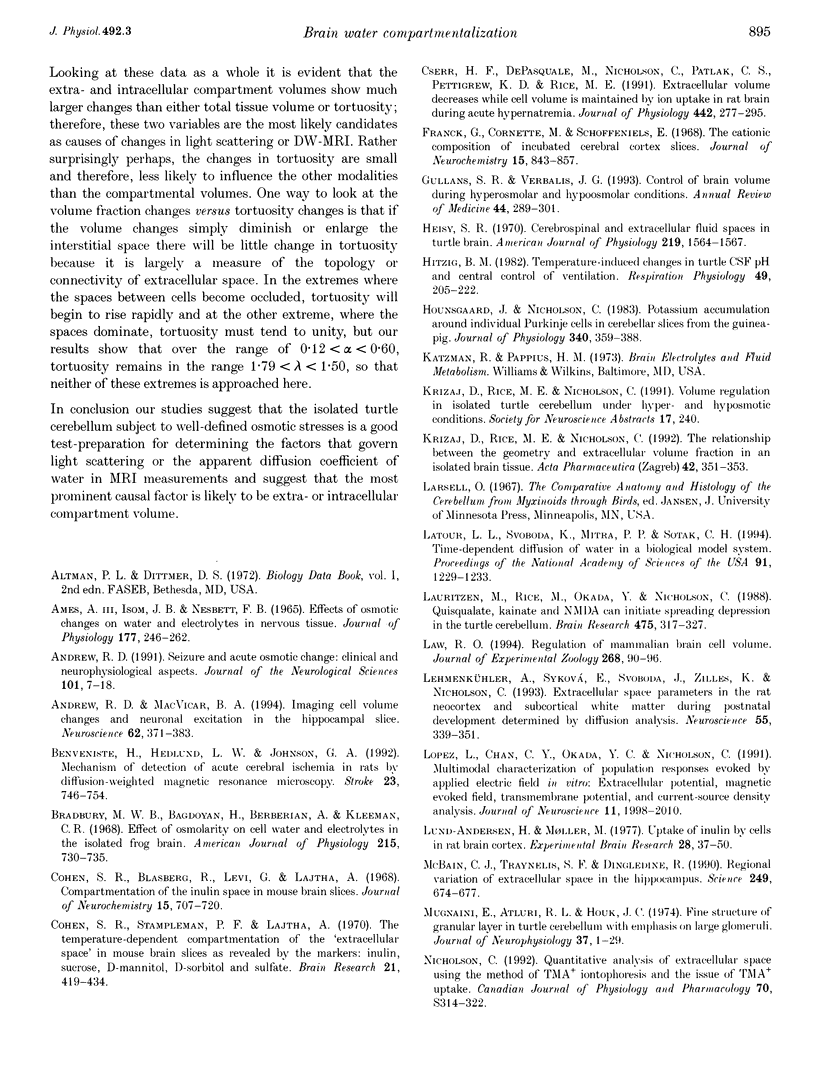Abstract
1. Water compartmentalization in the turtle cerebellum subject to media of different osmolalities was quantified by combining extracellular diffusion analysis with wet weight and dry weight measurements. The diffusion analysis also determined the tortuosity of the extracellular space. 2. Isolated cerebella were immersed in normal, oxygenated physiological saline (302 mosmol kg-1), hypotonic saline (238 mosmol kg-1) and a series of hypertonic salines (up to 668 mosmol kg-1). The osmolality was varied by altering the NaCl content. 3. Extracellular volume fraction and tortuosity of the granular layer of the cerebellum were determined from measurements of ionophoretically induced diffusion profiles of tetramethylammonium, using ion-selective microelectrodes. The volume fraction was 0.22 in normal saline, 0.12 in hypotonic medium and 0.60 in the most hypertonic medium. Tortuosity was 1.70 in the normal saline, 1.79 in the hypotonic and 1.50 in the most hypertonic saline. 4. The water content, defined as (wet weight-dry weight)/wet weight, of a typical isolated cerebellum (including granular, Purkinje cell and molecular layers) was 82.9%. It increased to 85.2% in hypotonic saline and decreased to 80.1% in the most hypertonic saline. 5. Measurements of extracellular volume fraction and water content were combined to show that hypotonic solutions caused water to move from the extracellular to the intracellular compartment while hypertonic solutions caused water to move from the intracellular to extracellular compartment, with only a relatively small changes in total water in both cases. 6. These results suggest the use of the isolated turtle cerebellum as a model system for studying light scattering or diffusion-weighted magnetic resonance imaging.
Full text
PDF









Selected References
These references are in PubMed. This may not be the complete list of references from this article.
- AMES A., 3rd, ISOM J. B., NESBETT F. B. EFFECTS OF OSMOTIC CHANGES ON WATER AND ELECTROLYTES IN NERVOUS TISSUE. J Physiol. 1965 Mar;177:246–262. doi: 10.1113/jphysiol.1965.sp007590. [DOI] [PMC free article] [PubMed] [Google Scholar]
- Andrew R. D., MacVicar B. A. Imaging cell volume changes and neuronal excitation in the hippocampal slice. Neuroscience. 1994 Sep;62(2):371–383. doi: 10.1016/0306-4522(94)90372-7. [DOI] [PubMed] [Google Scholar]
- Andrew R. D. Seizure and acute osmotic change: clinical and neurophysiological aspects. J Neurol Sci. 1991 Jan;101(1):7–18. doi: 10.1016/0022-510x(91)90013-w. [DOI] [PubMed] [Google Scholar]
- Bradbury M. W., Bagdoyan H., Berberian A., Kleeman C. R. Effect of osmolarity on cell water and electrolytes in the isolated frog brain. Am J Physiol. 1968 Sep;215(3):730–735. doi: 10.1152/ajplegacy.1968.215.3.730. [DOI] [PubMed] [Google Scholar]
- ELLIOTT K. A., PAPPIUS H. M. Water distribution in incubated slices of brain and other tissues. Can J Biochem Physiol. 1956 Sep;34(5):1007–1022. [PubMed] [Google Scholar]
- Gullans S. R., Verbalis J. G. Control of brain volume during hyperosmolar and hypoosmolar conditions. Annu Rev Med. 1993;44:289–301. doi: 10.1146/annurev.me.44.020193.001445. [DOI] [PubMed] [Google Scholar]
- Hitzig B. M. Temperature-induced changes in turtle CSF pH and central control of ventilation. Respir Physiol. 1982 Aug;49(2):205–222. doi: 10.1016/0034-5687(82)90074-3. [DOI] [PubMed] [Google Scholar]
- Hounsgaard J., Nicholson C. Potassium accumulation around individual purkinje cells in cerebellar slices from the guinea-pig. J Physiol. 1983 Jul;340:359–388. doi: 10.1113/jphysiol.1983.sp014767. [DOI] [PMC free article] [PubMed] [Google Scholar]
- Lauritzen M., Rice M. E., Okada Y., Nicholson C. Quisqualate, kainate and NMDA can initiate spreading depression in the turtle cerebellum. Brain Res. 1988 Dec 20;475(2):317–327. doi: 10.1016/0006-8993(88)90620-8. [DOI] [PubMed] [Google Scholar]
- Lehmenkühler A., Syková E., Svoboda J., Zilles K., Nicholson C. Extracellular space parameters in the rat neocortex and subcortical white matter during postnatal development determined by diffusion analysis. Neuroscience. 1993 Jul;55(2):339–351. doi: 10.1016/0306-4522(93)90503-8. [DOI] [PubMed] [Google Scholar]
- Nicholson C., Hounsgaard J. Diffusion in the slice microenvironment and implications for physiological studies. Fed Proc. 1983 Sep;42(12):2865–2868. [PubMed] [Google Scholar]
- Nicholson C. Ion-selective microelectrodes and diffusion measurements as tools to explore the brain cell microenvironment. J Neurosci Methods. 1993 Jul;48(3):199–213. doi: 10.1016/0165-0270(93)90092-6. [DOI] [PubMed] [Google Scholar]
- Nicholson C., Phillips J. M. Ion diffusion modified by tortuosity and volume fraction in the extracellular microenvironment of the rat cerebellum. J Physiol. 1981 Dec;321:225–257. doi: 10.1113/jphysiol.1981.sp013981. [DOI] [PMC free article] [PubMed] [Google Scholar]
- Norris D. G., Niendorf T., Leibfritz D. Health and infarcted brain tissues studied at short diffusion times: the origins of apparent restriction and the reduction in apparent diffusion coefficient. NMR Biomed. 1994 Nov;7(7):304–310. doi: 10.1002/nbm.1940070703. [DOI] [PubMed] [Google Scholar]
- Okada Y. C., Huang J. C., Rice M. E., Tranchina D., Nicholson C. Origin of the apparent tissue conductivity in the molecular and granular layers of the in vitro turtle cerebellum and the interpretation of current source-density analysis. J Neurophysiol. 1994 Aug;72(2):742–753. doi: 10.1152/jn.1994.72.2.742. [DOI] [PubMed] [Google Scholar]
- Pérez-Pinzón M. A., Tao L., Nicholson C. Extracellular potassium, volume fraction, and tortuosity in rat hippocampal CA1, CA3, and cortical slices during ischemia. J Neurophysiol. 1995 Aug;74(2):565–573. doi: 10.1152/jn.1995.74.2.565. [DOI] [PubMed] [Google Scholar]
- Rice M. E., Nicholson C. Diffusion characteristics and extracellular volume fraction during normoxia and hypoxia in slices of rat neostriatum. J Neurophysiol. 1991 Feb;65(2):264–272. doi: 10.1152/jn.1991.65.2.264. [DOI] [PubMed] [Google Scholar]
- Rice M. E., Okada Y. C., Nicholson C. Anisotropic and heterogeneous diffusion in the turtle cerebellum: implications for volume transmission. J Neurophysiol. 1993 Nov;70(5):2035–2044. doi: 10.1152/jn.1993.70.5.2035. [DOI] [PubMed] [Google Scholar]
- Shigeno T., Brock M., Shigeno S., Fritschka E., Cervós-Navarro J. The determination of brain water content: microgravimetry versus drying-weighing method. J Neurosurg. 1982 Jul;57(1):99–107. doi: 10.3171/jns.1982.57.1.0099. [DOI] [PubMed] [Google Scholar]
- Strange K. Regulation of solute and water balance and cell volume in the central nervous system. J Am Soc Nephrol. 1992 Jul;3(1):12–27. doi: 10.1681/ASN.V3112. [DOI] [PubMed] [Google Scholar]


